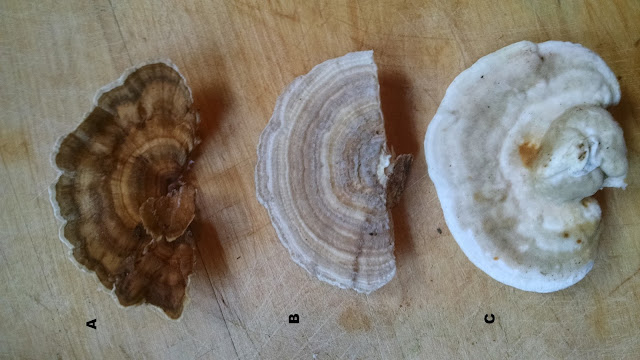Turkey Tail Identification and Uses
Trametes versicolor, or Turkey Tail Mushroom, is getting a lot of attention these days for its proven ability to fight certain cancers in controlled studies. Early on, we noticed some bracket fungi that looked something like turkeys growing on dead wood around our house, but we quickly dismissed them as "other" using a simple identification test. However, as we have introduced wood from different forests (we have to get our mushroom and firewood logs somewhere, and our little 1/2 acre is not exactly providing all those needs) turkeys have started popping up everywhere. We weren't really planning on getting into medicinals this soon, but when they just showed up, we knew they were not going anywhere, so we'd better start learning how to use them.
First, let's cover that aforementioned simple identification test: I used Michael Kou's "Totally True Turkey Tail Test", a six-part yes/no questionnaire to look at the three candidates I found around our place.
- The mushroom should have TINY pores on the underside. In my photos, below, "A" has truly tiny pores, while "B" has gills, and "C" has visibly large pores. (This is actually broken down into two questions in Dr Kou's test.)
- The sample's cap should be conspicuously fuzzy. Although "C" is smooth, both of my other examples are fuzzy.
- The fresh cap should not be whitish to grayish. "B" and "C" both fit this bill.
- The cap should have starkly contrasting color zones. This one is the hardest for me to justify, since there is so much nuance in even the same species on the same log, let alone samples taken from different places. Look at my samples: all of them have varying degrees of starkly contrasting zones, but "A" is clearly starker than the others.
- The fresh cap should be thin and flexible. Although I didn't bend the samples for the photos, I can attest that "C" was neither thin nor flexible.
So, although all of these mushrooms from my little foray hit "positive" on some of the questions, only one was positive on ALL of the questions. That's our Turkey Tail, and we are picking them as fast as they are growing. Remember, they are technically a contaminant in our mushroom garden, competing against our culinary mushroom varieties for nutrients. We are happy to use them as they come, but we also want to keep them from spreading as much as possible.
We keep a bag of dry ones on hand to use in teas, and we make tinctures whenever we've dried enough to pack a mason jar full. The tinctures and dry mushrooms will be available from our etsy store, and maybe at the Woodstock Farmers' Market, if we are able to get a booth this coming season.
Maybe this flush of turkeys will move some of our production in that direction. We've been thinking about reshi, and several of the "culinary" varieties we already grow also have medicinal properties. It doesn't seem like quite the leap it did before the turkeys arrived.
Maybe this flush of turkeys will move some of our production in that direction. We've been thinking about reshi, and several of the "culinary" varieties we already grow also have medicinal properties. It doesn't seem like quite the leap it did before the turkeys arrived.





Oh man i thought you were gonna be able to tell me what "C" was I found this and the only thing i know is that it is a pollipore.
ReplyDelete